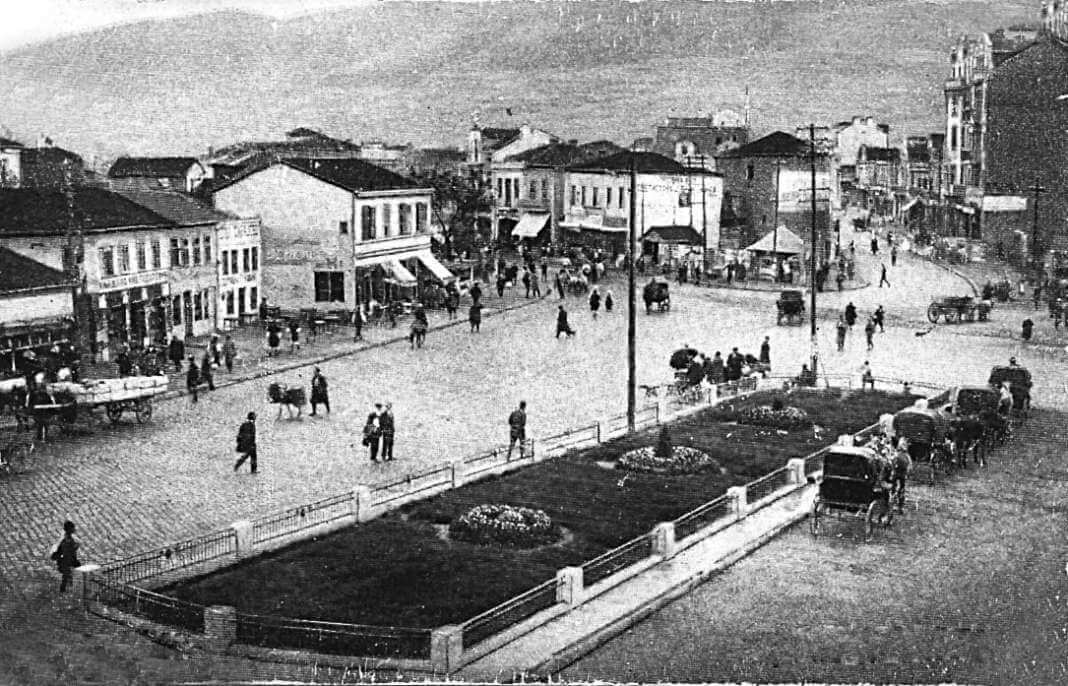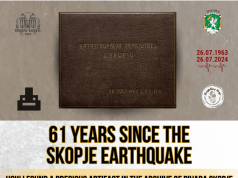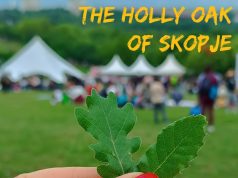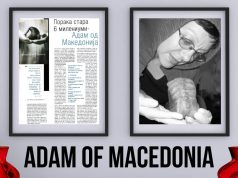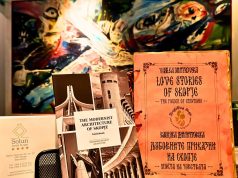The photograph depicts Skopje Square in the 1920s. The constructed houses of Nastevi (1922) and the Ikonomovi house (1920-22) are visible, but Ristik’s Palace (1926) is not yet present. The photograph can be dated between 1922 and no later than 1925, as the construction of Ristik’s Palace began in 1925 and was completed one year later. The original of this photograph is preserved in the archives of the DARM – Skopje department. It was discovered a few years ago during a large project with HAEMUS focusing on old Skopje between the two world wars.
As can be observed from many other photographs, from the mid-1920s to the mid-1930s, the primary means of transportation in Skopje was the carriage. A certificate issued by the Municipality Court of the city of Skopje attests that not only were the prices for carriage transportation regulated, but the destinations were also known. The starting point was the Railway Station, not the one known today as the “Old Railway Station” but the one located where the current “Mala Stanica” is. Lines operated from there to Chair, Treska, Debar Maalo, Tashino Chesmiche, and St. Petka, providing a glimpse of the physical expansion of the city of Skopje during the period after the First World War.

From the railway station, there was a special line with a carriage to the Skopje brewery. The transportation cost was 25 dinars for one person in one direction, 30 dinars for 2 persons, 50 dinars for three or four persons, and if the stop was not longer than 10 minutes, half of the same fee was paid for the return. If the stop was longer, which was likely in the case of the brewery, the price was calculated based on waiting time.
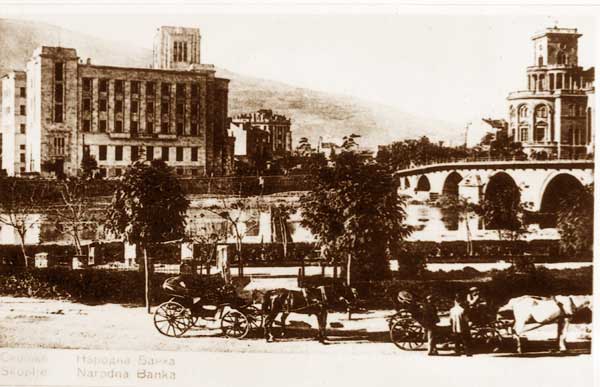
This archival document from the Municipality Court of the city of Skopje does not have a date, but we can assume it is probably from the period after 1925 since the Parna Brewery AD Skopje was founded in 1922, and in June 1924, it started producing its brand “Skopsko.” Located in the industrial zone “Keramidnitsa” outside the city, we can only assume that it became a kind of attraction for citizens when the municipality of Skopje established a special transportation line there.
In the period from 1918-1941, Skopje had a large number of carriages providing passenger transportation within and outside the city. There was even an Association of Carriage Drivers with about 500 members. They worked in day and night shifts and were obligated to undergo mandatory annual registration and inspection. In addition to city transportation and strolls, carriages were also used for weddings and funerals. Even the municipality of the city of Skopje had its own fleet. In 1923, it owned: 2 carriages for municipal officials, 2 funeral cars, 1 car with a barrel for cleaning toilets, and by 1926, two more carriages, a new funeral car, and a car for cleaning toilets with septic tanks were acquired. In 1930, there were 153 private and public carriages and 482 registered cars for the transportation of goods.
The text was originally published on the website of Pivara Skopje AD, a bit later on Vasilka Dimitrovska’s web site.
The text has been adapted and partially revised from the original scientific-research project by HAEMUS titled “Study on the History of Parna Pivara Skopje AD,” by authors Vasilka Dimitrovska and Aleksandar Madjovski, commissioned and supported by Pivara Skopje AD.
Bibliography:
[1] Dimitrovska Vasilka, Madzhovski Aleksandar (2017), Study on Debar Maalo, intangible cultural heritage – development of a study to define the Bohemian Quarter as a cultural attraction based on the cultural-historical and anthropological context in the last century, with an emphasis on the first half of the 20th century, HAEMUS, Skopje (unpublished scientific-research study).
[2] Kacheva Ala, Hristova Slavica, Gjorgiovska Tatjana (2006), Carriage, The City of Skopje, and the Formation of the Civil Class between the Two World Wars (1918-1941) – from an ethnological aspect, Museum of the City of Skopje, Skopje.
[3] Certificate of prices for carriage transportation throughout the city of Skopje, issued by the Municipality Court of the city of Skopje, DAR Museum, OS, F: City Headship of the Municipality of the City of Skopje – Skopje (1918-1941), k: 42, a.e 51 (the original document is in Cyrillic script in Serbo-Croatian language, date unknown).
[4] DARMS – Skopje department
[5] Transcript of the request of Parna Pivara AD Skopje to approve the installation of a brewery in the location Keramidnitsa, DAR Museum, OS, F: City Headship of the Municipality of the City of Skopje – Skopje (1918-1941), (the original document is in Cyrillic script in Serbo-Croatian language, December 16, 1922).
[6] Municipal vehicle park, “Almanac of the Municipality of the city of Skopje 1918-1928,” Skopje 1928, 44.
[7] Photo Archive of the Museum of the City of Skopje



